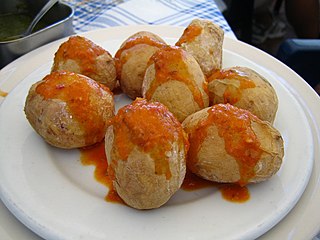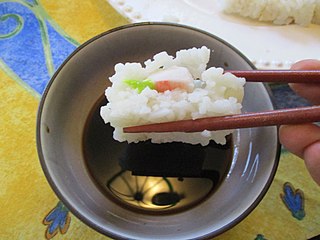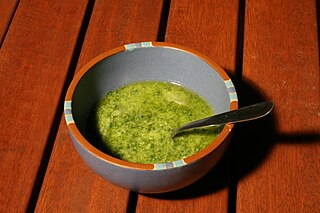
Turkish cuisine is largely the heritage of Ottoman cuisine, which can be described as a fusion and refinement of Mediterranean, Balkan, Middle Eastern, Central Asian, Eastern European and Armenian cuisines. Turkish cuisine has in turn influenced those and other neighbouring cuisines, including those of Southeast Europe (Balkans), Central Europe, and Western Europe. The Ottomans fused various culinary traditions of their realm with influences from Levantine cuisines, Egyptian cuisine, Greek cuisine, Balkan cuisine, along with traditional Turkic elements from Central Asia, creating a vast array of specialities.

Puerto Rican cuisine has its roots in the cooking traditions and practices of Europe, Africa and the native Taínos. Starting from the latter part of the 19th century. Puerto Rican cuisine can be found in several other countries.
The Albanian cuisine is a representative of the cuisine of the Mediterranean. It is also an example of the Mediterranean diet based on the importance of olive oil, fruits, vegetables and fish. The cooking traditions of the Albanian people are diverse in consequence of the environmental factors that are more importantly suitable for the cultivation of nearly every kind of herbs, vegetables and fruits. Olive oil is the most ancient and commonly used vegetable fat in Albanian cooking, produced since antiquity throughout the country particularly along the coasts.

A crouton is a piece of rebaked bread, often cubed and seasoned. Croutons are used to add texture and flavor to salads—notably the Caesar salad—as an accompaniment to soups and stews, or eaten as a snack food.

Scrambled eggs is a dish made from eggs stirred, whipped or beaten together while being gently heated, typically with salt, butter and sometimes other ingredients.

Mojo is the name, or abbreviated name, of several types of sauces, varying in spiciness, consisting primarily of olive oil, local pepper varieties, garlic, paprika, cumin or coriander, and other spices. Mojo originated in the Canary Islands, where the main varieties are red mojo and green mojo. Other countries have recipes similar to mojo, where acidic ingredients such as vinegar, lemon, orange, or lime juice may be used.

Burrata is an Italian cow milk cheese made from mozzarella and cream. The outer casing is solid cheese, while the inside contains stracciatella and cream, giving it an unusual, soft texture. It is typical of Apulia.
Romanian cuisine is a diverse blend of different dishes from several traditions with which it has come into contact, but it also maintains its own character. It has been mainly influenced by Turkish and a series of European cuisines in particular from the Balkans, or Hungarian cuisine as well as culinary elements stemming from the cuisines of the Slavic-speaking countries of Eastern and Central Europe.
Latvian cuisine typically consists of agricultural products, with meat featuring in most main meal dishes. Fish is commonly consumed due to Latvia's location on the eastern shore of the Baltic Sea.

A dip or dipping sauce is a common condiment for many types of food. Dips are used to add flavor or texture to a food, such as pita bread, dumplings, crackers, cut-up raw vegetables, fruits, seafood, cubed pieces of meat and cheese, potato chips, tortilla chips, falafel, and sometimes even whole sandwiches in the case of au jus. Unlike other sauces, instead of applying the sauce to the food, the food is typically placed or dipped into the sauce.

Bulgarian cuisine is a representative of the Mediterranean cuisine of Southeast Europe. It shares characteristics with other Balkan cuisines. Bulgarian cooking traditions are diverse because of geographical factors such as climatic conditions suitable for a variety of vegetables, herbs, and fruit. Aside from the vast variety of local Bulgarian dishes.

Arab cuisine is the cuisine of the Arabs, defined as the various regional cuisines spanning the Arab world, from the Maghreb to the Fertile Crescent and the Arabian Peninsula. These cuisines are centuries old and reflect the culture of trading in spices, herbs, and foods. The regions have many similarities, but also unique traditions. They have also been influenced by climate, cultivation, and mutual commerce.

Italian cuisine is a Mediterranean cuisine consisting of the ingredients, recipes and cooking techniques developed across the Italian Peninsula since antiquity, and later spread around the world together with waves of Italian diaspora.

Pistou, or pistou sauce, is a Provençal cold sauce made from cloves of garlic, fresh basil, and olive oil. It is somewhat similar to the Ligurian sauce pesto, although it lacks pine nuts. Some modern versions of the recipe include grated parmesan, pecorino, or similar hard cheeses.
The traditional cuisine of Abruzzo is eclectic, drawing on pastoral, mountain, and coastal cuisine. Staples of Abruzzo cuisine include bread, pasta, meat, cheese, and wine. The isolation which has characterized the region for decades has ensured the independence of its culinary tradition from those of nearby regions. Confesercenti, an Italian trade organization, conducted a 2013 study which called Abruzzo the best place to dine in Italy.

Dumplings are a broad class of dishes that consists of pieces of dough wrapped around a filling, or of dough with no filling. The dough can be based on bread, flour or potatoes, and may be filled with meat, fish, cheese, vegetables, fruits or sweets. Dumplings may be prepared using a variety of methods, including baking, boiling, frying, simmering or steaming and are found in many world cuisines.

Patranque is a rural dish from Auvergne in France made by soaking stale bread in milk and tome fraîche or young Cantal cheese.













